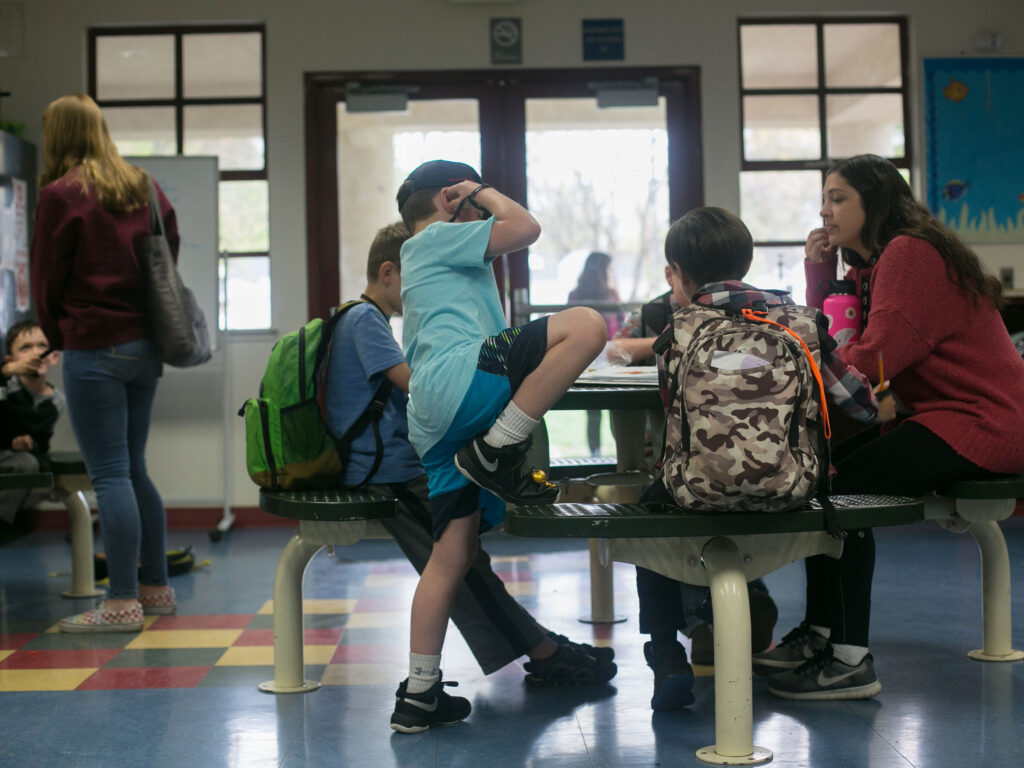
Students work on homework during an after-school program in Chico, the largest city in Butte County. (File photo)
Credit: Julie Leopo / EdSource
For nearly a decade, the Orange County Department of Education and the Butte County Office of Education have had the privilege of co-leading the implementation of the California Multi-Tiered System of Support (MTSS) — a statewide framework that’s transforming how schools serve students academically, socially, emotionally and behaviorally.
This work began with a simple but urgent goal: to ensure that every student in California — no matter their ZIP code, background or circumstance — has access to a responsive and coordinated system of supports that meets their individual needs.
Today, that vision is being realized in thousands of schools across the state, where educators are reporting measurable gains in academic performance, reductions in suspensions and absenteeism, and stronger alignment with initiatives like Universal Pre-kindergarten, the Expanded Learning Opportunities Program and Community Schools.
In short, California MTSS is working. And now is the time to sustain and expand its impact.
For those unfamiliar with the framework, the California Multi-Tiered System of Support is based on three levels of support:
- Universal instruction and strategies for all students.
- Targeted help for those who need more.
- Intensive interventions for students with the greatest needs.
What makes it so powerful isn’t just its flexibility or scalability — though those are important — but its ability to help schools work together more effectively and break down silos across California’s education system.
Our state has made historic investments in mental health, early learning, expanded instructional time and more. The multitiered system doesn’t replace those efforts — it ensures they work together. In other words, it’s the delivery system for every promise we’ve made to our students.
Consider these scenarios, drawn from real-life practices, to see how the framework can support students across different educational settings:
At an elementary school, a student who is reading below grade level benefits from universal supports built into the classroom for all learners. The teacher uses strategies like visual scaffolds — including maps, illustrations and diagrams to aid comprehension — along with flexible grouping based on reading levels and multiple ways for students to demonstrate understanding. These tools, part of a schoolwide commitment to Universal Design for Learning, help the student stay engaged and make steady progress without needing to be pulled out or referred for separate services.
In a middle school, a student who begins to withdraw socially and fall behind in assignments is connected with supplemental support. A school counselor checks in weekly, and the student joins a small group focused on building organization and self-regulation skills. With these added layers of support, the student regains confidence and starts participating more actively in class.
At an alternative high school, a student returning from an extended absence receives more intensive support. A personalized plan is created that includes one-on-one counseling, a flexible academic schedule, and regular collaboration between school staff and the student’s family. Over time, the student re-engages with learning and builds toward graduation.
As county leaders, we’ve seen firsthand how California MTSS helps schools weave together fragmented programs and services into a single, integrated system that responds to the whole child.
In some schools, that has meant fewer students being referred to special education thanks to earlier, research-based interventions. In others, it has led to improved school climates, stronger teacher-student relationships and higher graduation rates.
Crucially, this work has taken hold in settings as diverse as the state itself. California MTSS is driving progress in large urban districts, small rural schools and alternative education programs that serve some of our most vulnerable youth.
In Butte County, where educators often juggle multiple roles and resources are limited, the framework has provided structure and tools to meet local needs while maintaining alignment with statewide goals. These strategies have become a blueprint for many rural communities across California.
Meanwhile, in Orange County, the multitiered framework is helping schools tackle chronic absenteeism, expand mental health supports and ensure students are not just seen, but supported and successful.
California has emerged as a national leader in this work. Our state was the first to embed social-emotional learning and mental health into the multitiered system of support framework, and we’ve launched online certification modules to build capacity for administrators, teachers, counselors and even higher education faculty. The annual California MTSS Professional Learning Institute, which draws thousands of educators each summer, has become a hub for sharing evidence-based practices and building cross-county collaboration.
Yet like any systemic improvement effort, the long-term impact depends on sustained commitment. The current phase of statewide funding is set to conclude in 2026. Without additional investment, we risk stalling momentum — or worse, losing the progress we’ve made.
That’s why we’re jointly requesting a new round of funding — approximately $18 million annually over four years — to ensure that the framework continues to evolve and expand. Two-thirds of every dollar would go directly to schools, districts, county offices and fire-impacted regions to support coaching, trauma-informed practices and professional development. It would also fund large-scale research efforts and deepen implementation in classrooms, where it matters most.
The data speaks for itself. Recent studies show statistically significant improvements in reading and math scores in schools implementing the framework. Educators in rural communities report stronger collaboration and better outcomes. And thousands of students — including those with disabilities, those in foster care and those experiencing homelessness — are getting the supports they need, when they need them.
We believe the foundation is strong. Now is the time to build on it.
•••
Stefan Bean, Ed.D., is Orange County’s superintendent of schools. Mary Sakuma, Ed.D., is Butte County’s superintendent of schools.
The opinions expressed in this commentary represent those of the authors. EdSource welcomes commentaries representing diverse points of view. If you would like to submit a commentary, please review our guidelines and contact us.

دیدگاهتان را بنویسید